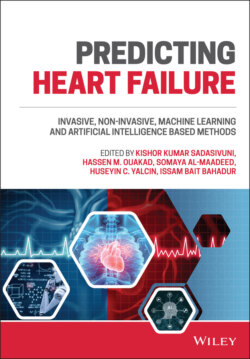Читать книгу Predicting Heart Failure - Группа авторов - Страница 77
2.5.2 AI in Electrocardiography
ОглавлениеElectrocardiography has a high impact in detecting abnormalities in heart rhythm. Most of the existing machine learning applications based on ECG focus on classification of electrical signals to spot abnormal activity in the heart. With today’s availability of ECG in small portable devices such as smartwatches, AI integration helps patients to monitor their heartbeat levels and detect any abnormalities that might require seeing a doctor or having further tests.
The work of Li et al. [28] applied a multichannel, multiscale deep neural network model to perform ECG classification of normal and abnormal signals, and their method achieved 96.02% accuracy. Other research work by Rajput el. [29] developed an automated ECG signal detection specifically for detecting the severity of hypertension, a high-risk factor for heart disease. Their method included using a two-band optimal biorthogonal wavelet bank filter as well as machine learning techniques to classify the wavelets into low, high-risk hypertension, and healthy. The average classification accuracy for this method was found to be 99.95%, and highlights the ability of this system to be deployed in clinics.
A method for ECG identification and detection of congestive heart failure (CHF) and arrhythmia (ARR) using deep learning techniques is that proposed by Eltrass et al. [30]. It mainly uses both CNN and constant-Q non-stationary Gabor transform (CQ-NSGT), which mainly transforms the 1D ECG signal to a 2D time-frequency representation. The output is then fed to a pretrained CNN model (AlexNet) to extract the features of these signals and then the features are used to diagnose the case by either classifying it as CHF, ARR, or normal sinus rhythm (NSR). The work achieved 98.82% accuracy, 98.87% sensitivity, 99.21% specificity, and 99.20% precision.
In the work by Moridani et al. [31], the authors experimented with multiple machine learning algorithms for ECG signal classification. They concentrated on performing preprocessing techniques for the initial signal and then applying feature extraction for both linear and nonlinear features for the heart rate variability as well as the application of statistical characteristics for the signal. Afterward, they used multilayer perceptron (MLP) and SVM, along with all features as well as optimal features to classify normal and abnormal signals in separate experiments. Their outcomes highlighted the performance of the SVM model that was able to get the highest accuracy while using all features and optimal features. For the optimal features, it achieved 98.3% accuracy, 99.10% sensitivity, and 97.5% specificity.
